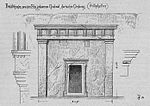Ear (ornament)
As ears or Ohrung is called the protruding corners of frames for windows and doors , furniture , paneling , paintings- and mirror frames. Refers to objects with ears as geohrt .
Overview
A distinction is made between the following types of ears in architecture, cabinet making and frame making:
Cranking occurs when a profile is angled at miters (corner connections) so that the profile jumps forward or backward. In the illustration, the profile is first angled to the left at miter 1, then upwards at miter 2 and finally to the right at miter 3, so that the corner is closed again by the emerging ear. |
Windows and doors
In the case of windows and doors, a distinction is made between protruding and cranked ears. Protruding ears are the parts of the lintel that protrude laterally beyond the soffit , the upper ears (Fig. 1–3), as well as the protruding ends of window sills and door sills , the lower ears (Fig. 3, 5). Cranking the corners of window and door frames (Fig. 4–5) also creates ears.
2. French window with protruding upper ears, Cal Bosch house, Mollerussa .
3. Window with protruding upper and lower ears, Chirk Castle, Wales .
4. Window with cranked upper ears, Rottenburg Diocesan Museum .
5. Door with cranked upper and lower ears, Evangelical Church in Köslau, Königsberg in Bavaria .
Furniture, paneling and frames
Ears on the corners of furniture, paneling, picture and mirror frames can be attached (Fig. 6–7) or cranked (Fig. 8–10). Set ears are formed by adding angle pieces to the frame corners.
6. Left half of a buffet with three decorative frames with attached ears.
7. Picture frame with double ears, Lawrence Alma-Tadema , portrait of Ignacy Jan Paderewski .
9. Picture frame with ears cranked 5 times, Ary Scheffer , portrait of Katarzyna Potocka.
10. Section of the paneling of the Fürsteneck room, Museum Angewandte Kunst , Frankfurt am Main, frame in the base area (green) with 3-way cranked ears.
history
This section deals with the history of the ears in architecture.
Greek antiquity
In ancient Greece, windows and doors could be decorated with cranked (Fig. 11, 13, 14) or protruding ears (Fig. 12, 15) on the lintel, window sill and threshold. According to Vitruvius , Doric doors "formed protrusions on the lintel ... to the right and left". The consoles called parotides (earlobes) by Vitruvius ( Fig. 11, Fig. 2, part f), which flank the lintel and frieze in Ionic doors and windows, are not called ears.
11. Ancient Greek doors after Vitruvius . - Fig. 1–3: Doric, Ionic and Attic door.
12. City gate of Troy , wooden gate with protruding upper and lower ears, François vase , 570 BC.
13. Window with cranked upper ears, west side of the Erechtheion , approx. 420–406 BC.
14th door with cranked upper and lower ears, Doric tomb in Antiphellos , 4th century BC.
15. Window with protruding upper and lower ears, Temple of Vesta in Tivoli , end of the 2nd century BC.
Roman times and Romanesque
According to Eugène Viollet-le-Duc , the Roman and Romanesque windows (Fig. 17) and doors had protruding ears on the crossbars below the lintel and above the window sill or threshold. This type of earing can also be found in later centuries (Fig. 18), in some cases the ears are also attached to other places on the frame, often in the middle of the reveal or even quite irregularly.
Modern times
The Renaissance , which also took up the ear ornament again (Fig. 19, 20) and used the motif in multiple variations in the High Renaissance , used not only lateral (upper and lower) ears, but also ears pointing upwards and hanging downwards. In his work on the architecture of the Italian Renaissance, Rudolf Redtenbacher distinguishes five variants ("Motive IV") for the arrangement of the ears.
In the relevant specialist literature there is a lack of monographic works on ears in architecture, so that general statements about ears in the stylistic epochs of modern times are not possible. Obviously, however, the ear motif is also widely used in the style epochs from the Renaissance to Historicism and Art Nouveau at the end of the 20th century.
16. Door with cranked upper ears (left), fresco from Pompeii , Naples National Archaeological Museum .
18. Window with protruding ears under the lintel, Can Saló house, 1690, Corçà, Girona province , Spain.
19. Window with cranked upper ears, Palazzo Massimo alle Colonne , Rome, 1532–1536.
20th door with cranked upper ears, Hôtel Montescot, Chartres , early 17th century.
glossary
In German, the terms Ohr and geohrt have prevailed, while Ohrung is rarely used. The older name Eckzierde or Eckenzierde is outdated. The term corner cube is also used for picture frames with cranked ears, which is derived from the construction of drilled frames.
| language | Technical term |
| German | Ear, ear |
| English | ear, crossette |
| French | crossette, oreillon |
| Italian | orecchio |
literature
General
- Hans Koepf ; Günther Binding : Picture Dictionary of Architecture. With English, French, Italian and Spanish technical glossaries Stuttgart 2005, pages 344–345 (ear).
- Theodor Krauth; Franz Sales Meyer : The building and art work of the stone mason, Volume 1: Text, Volume 2: Tafeln , Leipzig 1896, page 236, plate 23-25.
- Theodor Krauth; Franz Sales Meyer : The entire cabinet making with special consideration of the craft form, volume 1: text, volume 2: panels. Leipzig 1902, pages 48-49, Figures 10-13 on pages 36-38, 40.
- Johann Georg Krünitz : oekonomische encyklopädie , Vol. 10: From Ea to Em Berlin 1785, page 44 (Eckzierden, Eckenzierden), online: .
- Oscar Mothes (editor): Illustrirtes Bau-Lexikon. Practical help and reference book in the field of building and low-rise construction, land and hydraulic engineering, mill and mining, shipbuilding and war architecture, as well as the trades, arts and sciences related to construction, Volume 1: AE. Leipzig 1863, page 577 (Crossettes).
- Oscar Mothes (editor): Illustrirtes Bau-Lexikon. Practical help and reference book in the field of building and low-rise construction, land and hydraulic engineering, mill and mining, shipbuilding and war architecture, as well as the trades, arts and sciences related to construction, Volume 3: NZ. Leipzig 1868, page 34 (ear 6).
- Tobias Schmitz: Lexicon of European picture frames, Volume 2: The 19th century. Classicism, Biedermeier, Romanticism, Historicism, Art Nouveau. Solingen 2009, pages 27, 54 (corner cartouche, corner cube).
history
- Josef Durm : Handbook of Architecture. Second part: the architectural styles. Historical and Technical Development, Volume 2: The architecture of the Greeks , Darmstadt 1881, page 58-60 (Doric doors and windows), here: 58, 164-166 (ionic doors and windows), here: 165, online: .
- Josef Durm : Handbook of Architecture. Second part: the architectural styles. Historical and technical development, Volume 2: The architecture of the Etruscans. The architecture of the Romans , Darmstadt 1885, page 265 (doors and windows) : online .
- Josef Durm : Handbook of Architecture. First part: General building construction. Volume 2: The Building Design , Darmstadt 1896, page 143-162 (doors and windows), online: .
- Josef Durm : Handbook of Architecture. Second part: the architectural styles. Historical and technical development. Volume 5: The architecture of the Renaissance in Italy , Stuttgart 1903, page 243, online: .
- Johann Erdmann Hummel : The column orders according to Vitruvius, compiled with some column orders from the most excellent old monuments, and their deviations compared with the former, together with an appendix of the temple types. With an instruction how such according to correct proportions can be drawn. For teaching art schools, high schools, building enthusiasts and friends of architecture. Berlin 1840 Table XVIII-XX, online: .
- Rudolf Redtenbacher: The window openings. In: The Architecture of the Italian Renaissance. Development history and theory of forms of the same, a teaching and manual for architects and art lovers. Frankfurt am Main 1886, pages 318–328, especially: 324–325.
- Eugène Viollet-le-Duc : Dictionnaire raisonné de l'architecture française du XIe au XVIe siècle, Tome 5. Paris 1861, page 366-367 (Fenêtre), online: , 314-468 (Porte), online: .
Web links
Footnotes
- ↑ #Krauth 1902 , page 48.
- ↑ #Durm 1903 , #Mothes 1868 .
- ↑ #Mothes 1863 .
- ↑ #Durm 1881 , page 58, 165, #Durm 1885 , page 265.
- ↑ Vitruv IV 6.2, see #Reber 1865 , page 117.
- ^ Vitruv IV 6.4, see #Reber 1865 , page 118.
- ↑ Richard Delbrueck : Hellenistic buildings in Latium. Volume 2. Trübner, Strasbourg 1912, p. 19 Fig. 18 ( digitized version )
- ↑ # Viollet-le-Duc 1861
- ↑ See e.g. B. also file: Alzeyer-Schloss-10.JPG , file: Landeck Burgruine 11.jpg , file: Rundbogenfenster Eppelheim.JPG .
- ↑ See e.g. E.g . : file: Landeck Burgruine 11.jpg .
- ↑ See e.g. E.g .: File: Orange (8114228451) .jpg .
- ↑ #Durm 1903 , page 243, #Redtenbacher 1886 , page 324-325.
- ↑ Example: the guard house of the garrison rifle house in Stuttgart in the Swiss style ( file: Garrison rifle house, 016.jpg ).
- ↑ Example: Oberbilker Allee 327 and 329 in Düsseldorf- Oberbilk ( file: Haeuser Oberbilker Allee 327 and 329 in Duesseldorf-Oberbilk, from Norden.jpg ).
- ↑ # Krünitz 1785 .
- ↑ #Schmitz 2009 , e.g. B. page 54.
- ↑ #Koepf 2005 , page 345.
- ↑ See: Merriam Webster's Revised Unabridged Dictionary, 1913 .
- ↑ #Koepf 2005 , page 345.























